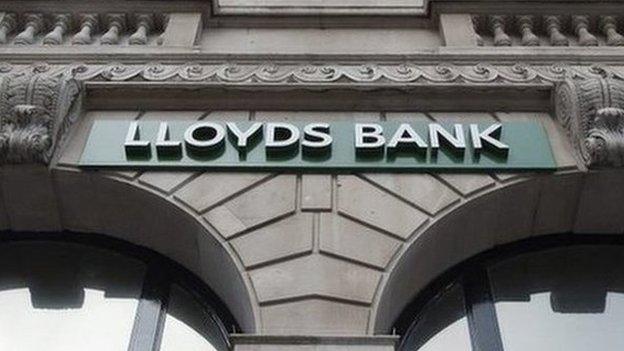High Street branches are still important for Lloyds
- Published
- comments

Lloyds has announced that it is closing up to 7% of its bank branch network. With figures showing that transactions in branches across the sector are down as much as 30% since 2010, many judge that is a relatively low number.
The reason the number is not higher is simple. With threats approaching from digital payment systems such as Apple Pay and Google Wallet, traditional banks know that a presence in bricks-and-mortar is one advantage they have over their future internet rivals.
Lloyds has over 2,200 branches in the UK. It will close 200 branches and, interestingly, open 50.
It doesn't want to get out of branch banking. It wants a new type of branch, complete with iPads and facilitated internet discussion screens, enabling chats with staff who may not be physically in the same branch as the customer.
Seeing a customer face-to-face or via Skype makes "up-selling" easier - that is, encouraging someone to take on an insurance product or open a savings account. For that, branches are important.
It also saves on headcount, with Lloyds looking at opening some more remote branches for shorter hours so that staff can support a wider network.
Banks, of course, are still victim to changes on the High Street. One banking chief executive has been heard to say that his busiest branch is the 7.20 commuter service into Waterloo. People on the train are doing their banking on their mobile phone.
The problem is, most banks have a branch network built for an era when customers (both individuals and businesses) would make weekly visits to a branch to pay in money and check their account.
Stress tests
I remember regular trips to the local branch of NatWest with my mother when I was a child. That branch in west London is now an estate agent.
The chief executive of Lloyds, Antonio Horta-Osorio, is widely considered to have done a huge amount to turn the banking group around, fulfilling his pledge to make the bank as simple as possible - taking deposits on one side and lending money to customers and businesses on the other.
Underlying costs are down 6% and profit margins on large parts of the business are improving.
But there are lots of risks ahead. On 16 December the Bank of England will publish its "stress tests" of British banks, war gaming an economic doomsday scenario where house prices collapse, interest rates spike and unemployment rises rapidly.
Last Sunday, it was announced that Lloyds had passed similar - but not as brutal - Europe-wide stress tests. But of the big four - HSBC, Royal Bank of Scotland and Barclays are the others - Lloyds came closest to failing.
Lloyds says that the European stress tests were based on 2013 figures and that 2014 has seen the bank strengthen its balance sheet.
But since those stress tests by the European Banking Authority, its share price has fallen by more than 2%.
That figure was down again on Tuesday morning.
Sale
Investors are concerned that Lloyds still has work to do on its internal financial strength. Tuesday's announcement of another £900m provision for payment protection insurance mis-selling will not have settled nerves.
Downward pressure on the share price is also a judgement on whether Lloyds might be able to pay its first dividend since the financial crisis by the end of the financial year, next March.
The Bank of England has yet to pass judgement on that. And although Lloyds' chief financial officer, George Culmer, said he was hopeful of a "yes", given the stress test results and the figures on Tuesday, few are predicting any moves before December.
Taken together, all these factors make the possibility that the government will sell its remaining 25% in Lloyds before the next election a remote one.
The government's "in-price" - that is, the amount it paid to rescue Lloyds during the financial crisis - is judged to be around 74p a share.
On Tuesday, Lloyds' share price was trading at 73.5p. Take into account the discount the government would have to apply to make the sale attractive and you can see the problem.